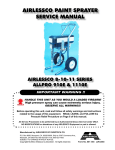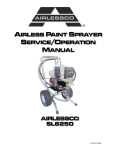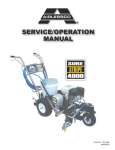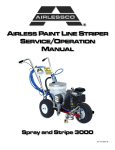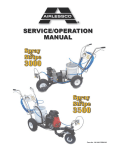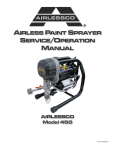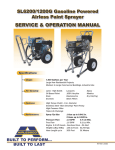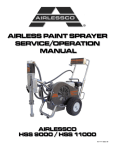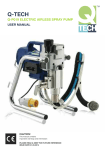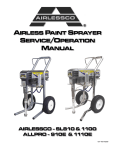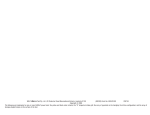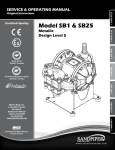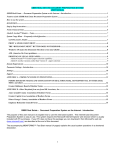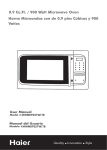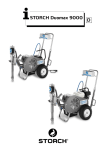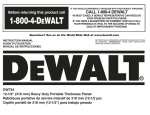Download AIRLESSCO HSS9000 Specifications
Transcript
SERVICE /OPERATION MANUAL HSS 9000 Hydraulic Airless Paint Sprayer Form No. 001-771 JUN07 TABLE OF CONTENTS INTRODUCTION ................................................................................................... 1 SAFETY WARNINGS ............................................................................................ 2 GAS ENGINE PRECAUTIONS ............................................................................. 5 FLUSHING ............................................................................................................ 7 HOW TO FLUSH....................................................................... ............................ 8 SETTING UP ......................................................................................................... 9 PRESSURE RELIEF PROCEDURE ................................................................... 11 SPRAY GUN OPERATION.................................................................................. 12 SRAYING TROUBLESHOOTING CHART .......................................................... 13 REV-TIP™ SELECTION CHART ........................................................................ 14 FIELD TROUBLESHOOTING ............................................................................. 15 SERVICING THE FLUID PUMP.......................................................................... 16 SERVICING OUTLET VALVE ASSEMBLY.......................................................... 17 SERVICING INLET VALVE ASSY, INLET SUCTION ASSEMBLIES................... 18 OPTIONAL SUCTION ASSEMBLIES.................................................................. 19 PACKING REPLACEMENT PROCEDURES ...................................................... 20 PAINT PUMP ASSEMBLY ................................................................................... 21 MANIFOLD FILTER............................................................................................. 22 PRIME VALVE ASSEMBLY ................................................................................. 23 HYDRAULIC PUMP AND RESERVOIR.............................................................. 24 HYDRAULIC INLET AND MOTOR ASSEMBLIES .............................................. 25 FRAME ASSEMBLY ............................................................................................ 26 DIRECT IMMERSION ASSEMBLY ..................................................................... 27 SIPHON UNIT ASSEMBLY ................................................................................. 28 MOTOR/ENGINE W/CARRY PLATE ASSEMBLY .............................................. 29 AIRLESSCO by Durotech Co. 5397 N. Commerce Ave., Moorpark, CA 93021 Tel: 805-523-0211 FAX: 805-523-1063 2 Internet: www.airlessco.com Email: [email protected] Specifications subject to change without notice. INTRODUCTION Your new Airlessco airless paint sprayer is designed to meet the demands of the professional painting contractor as well as the homeowner. The famous Airlessco slow-stroking stainless steel piston pump delivers extra long life for the piston, packings, valve seats and balls. The patented Triple-Life packing system is externally adjustable extending packing life and reducing repacking costs. Its’ large high-torque electric motor runs slower reducing heat. And the motor is fan cooled and totally enclosed to reduce brush wear, and to prevent the ignition of paint fumes in the motor. HSS 9000 Max. Pressure Max. Hose Length Weight Bare 3300 PSI 300 FT 140 Lbs TEFC 1.25HP Electric Motor: Output 1.25 GPM Max Tip Size .036" 1-Gun .026" 2-Guns 6.5HP Gas Engine: Output Max Tip Size 2.7 GPM .052" 1-Gun .038" 1-Guns HANDLE THIS UNIT AS YOU WOULD A LOADED FIREARM! High pressure spray can cause extremely serious injury. OBSERVE ALL WARNINGS! Before operating this unit, read and follow all safety warnings and instructions related to the usage of this equipment on pages 2, 3 & 4. READ, LEARN, and FOLLOW the Pressure Relief Procedure on Page 11 of this manual. All Service Procedures to be performed by an Authorized Airlessco Service Center ONLY. NO MODIFICATIONS or alterations of any AIRLESSCO Equipment or part is allowed. MANUAL NOTATIONS WARNING - Alerts user to avoid or correct conditions that could cause bodily injury. CAUTION - Alerts user to avoid or correct conditions that could cause damage to or destruction of equipment. IMPORTANT - Alerts users to steps or procedures that are essential to proper equipment repair and maintenance. NOTE - Identifies essential procedures or extra information. 1 SAFETY WARNINGS HIGH PRESSURE SPRAY CAN CAUSE EXTREMELY SERIOUS INJURY. Handle as you would a loaded firearm. Follow the PRESSURE RELIEF PROCEDURE. DO NOT USE HALOGENATED SOLVENTS IN THIS SYSTEM. The prime valve, and most airless guns have aluminum parts and may explode. Cleaning agents, coatings, paints or adhesives may contain halogenated hydrocarbon solvents. DON'T TAKE CHANCES! Consult your material suppliers to be sure. Some of the most common of these solvents are: Carbontetrachloride, Chlorobenzene, Dichloroethane, Dichloroethyl Ether, Ethylbromide, Ethylchloride, Tethrachloethane. Alternate valves and guns are available if you need to use these solvents. MEDICAL ALERT - Airless Spray Wounds If any fluid appears to penetrate your skin, get EMERGENCY MEDICAL CARE AT ONCE. DO NOT TREAT AS A SIMPLE CUT. Tell the doctor exactly what fluid was injected. directly into the blood stream. Consultation with a plastic surgeon or reconstructive hand surgeon may be advisable. INJECTION HAZARD GENERAL PRECAUTIONS • Fluids under high pressure from spray or leaks can penetrate the skin and cause extremely serious injury, including the need for amputation. • NEVER alter equipment in any manner. • NEVER point the spray gun at anyone or any part of the body. • NEVER spray highly flammable materials. • NEVER put your hand or fingers over the spray tip. Do not use a rag or any other materials over your fingers. Paint will penetrate through these materials & into the hand. • NEVER allow another person to use sprayer unless he is thoroughly instructed on its safe use and given this operators manual to read. • NEVER try to stop or deflect leaks with your hand or body. • ALWAYS wear a spray mask, gloves and protective eye wear while spraying. • ALWAYS have the tip guard in place when spraying. • ALWAYS lock the gun trigger when you stop spraying. • ALWAYS remove tip from the gun to clean it. • NEVER try to "blow back" paint, this is not an air spray sprayer. • ALWAYS follow the PRESSURE RELIEF PROCEDURE before cleaning or removing the spray tip or servicing any system equipment. • Be sure the equipment safety devices are operating properly before each use. • Tighten all of the fluid connections before each use. MEDICAL TREATMENT\ • If any fluid appears to penetrate your skin, get EMERGENCY CARE AT ONCE! DON'T TREAT AS A SIMPLE CUT. • Go to an emergency room immediately. • Tell the doctor you suspect an injection injury. • Tell him what kind of material you were spraying with and have him read NOTE TO PHYSICIAN above. 2 NOTE TO PHYSICIAN: Injection in the skin is a traumatic injury. It is important to treat the injury surgically as soon as possible. DO NOT DELAY treatment to research toxicity. Toxicity is a concern with some exotic coatings injected • NEVER smoke while in spraying area. • NEVER use around children. • ALWAYS ensure fire extinquishing equipment is readily available and properly maintained. NEVER LEAVE SPRAYER UNATTENDED WITH PRESSURE IN THE SYSTEM. FOLLOW PRESSURE RELIEF PROCEDURES. NOTE: United States Government safety standards have been adopted under the Occupational Safety & Health Act. These standards, particularly the General Standards, Part 1910 & Construction Standards, Part 1926 should be consulted. SAFETY WARNINGS ALWAYS INSPECT SPRAYING AREA HOSES • Keep the spraying area free from obstructions. • Tighten all of the fluid connections securely before each use. High pressure fluid can dislodge a loose coupling or allow high pressure spray to be emitted from the coupling and result in an injection injury or serious bodily injury. • Make sure the spraying area has good ventilation to safely remove vapors and mists. • NEVER keep flammable material in spraying area. • NEVER spray in vicinity of open flame or other sources of ignition. • The spraying area must be at least 20 ft. away from spray unit. SPRAY GUN SAFETY • ALWAYS set gun safety lock in the "LOCKED" position when not in use & before servicing or cleaning. • NEVER remove or modify any part of the gun. • ALWAYS REMOVE THE SPRAY TIP when cleaning. Flush unit at the LOWEST POSSIBLE PRESSURE. • ALWAYS check operation of all gun safety devices before each use. • Be very careful when removing the spray tip or hose from the gun. A plugged line will contain fluid under pressure. If the tip or line is plugged, follow the PRESSURE RELIEF PROCEDURE. TIP GUARD • ALWAYS have the tip guard in place on the spray gun while spraying. The tip guard alerts you to the injection hazard and helps prevent accidentally placing your fingers or any part of your body close to the spray tip. SPRAY TIP SAFETY • Use extreme caution when cleaning or changing spray tips. If the spray tip clogs while spraying, engage the gun safety latch immediately. ALWAYS follow the PRESSURE RELIEF PROCEDURE and then remove the spray tip to clean it. • NEVER wipe off build up around the spray tip. TOXIC FLUID HAZARD • ALWAYS remove tip guard & tip to clean AFTER pump is turned off and the pressure is relieved by following the PRESSURE RELIEF PROCEDURE. • Hazardous fluid or toxic fumes can cause serious injury or death if splashed in eyes or on skin, inhaled or swallowed. Know the hazards of the fluid you are using. Store & dispose of hazardous fluid according to manufacturer, local, state & national guidelines. • ALWAYS wear protective eyewear, gloves, clothing and respirator as recommended by fluid manufacturer. • Only use hoses with a spring guard. The spring guard helps protect the hose from kinks or other damage which could result in hose rupture and cause an injection injury. • NEVER use a damaged hose, which can result in hose failure or rupture and cause an injection injury or other serious bodily injury or property damage. Before each use, check entire hose for cuts, leaks, abrasions, bulging of the cover, or damage or movement of couplings. If any of these conditions exist, replace the hose immediately. • NEVER use tape or any device to try to mend the hose as it cannot contain the high pressure fluid. NEVER ATTEMPT TO RECOUPLE THE HOSE. A high pressure hose is not recoupleable. GROUNDING • Ground the sprayer & other components in the system to reduce the risk of static sparking, fire or explosion which can result in serious bodily injury and property damage. For detailed instructions on how to ground, check your local electrical code. • ALWAYS ensure switch is in OFF position before plugging unit in. Always Ground All of These Components: 1. Sprayer: plug the power supply cord, or extension cord, each equipped with an undamaged three-prong plug, into a properly grounded outlet. DO NOT USE AN ADAPTER. Use only a 3 wire extension cord that has a 3 blade grounding plug, and a 3 slot receptacle that will accept the plug on the product. Make sure your extension cord is in good condition. When using an extension cord, be sure to use one heavy enough to carry the current your product will draw. (Note: The table on the top of the next page shows the correct size to use depending on cord length and name plate ampere rating. If in doubt, use the next heavier gauge. The smaller the gauge number, the heavier the cord.) 2. Fluid hose: use only grounded hoses. 3. Spray gun or dispensing valve: grounding is obtained through connection to a properly grounded fluid hose and pump. 4. Object being sprayed: according to your local code. 5. All solvent pails used when flushing. • Once each week, check electrical resistance of hose (when using multiple hose assemblies, check overall resistance.) Overall (end to end) resistance of unpressurized hose must not exceed 29 megohms (max.) for any coupled length or combination of hose lengths. If hose exceeds these limits, replace it immediately. • Never exceed 500 ft. (150 m) overall combined cord length to assure electrical continuity. 3 SAFETY WARNINGS Always Follow Recommended Pressure and Operating Instructions KEEP CLEAR OF MOVING PARTS Keep clear of moving parts when starting or operating the sprayer. Do not put your fingers into any openings to avoid amputation by moving parts or burns on hot parts. Precaution is the best insurance against an accident. When starting the motor, maintain a safe distance from moving parts of the equipment. Before adjusting or servicing any mechanical part of the sprayer, follow the PRESSURE RELIEF PROCEDURE. AVOID COMPONENT RUPTURE • This sprayer operates at 3000 psi (205 bar). Always be sure that all components and accessories have a maximum working pressure of at least 3000 psi to avoid rupture which can result in serious bodily injury including injection and property damage. • NEVER leave a pressurized sprayer unattended to avoid accidental operation of it, which could result in serious bodily injury. • ALWAYS follow the PRESSURE RELIEF PROCEDURE whenever you stop spraying and before adjusting, removing or repairing any part of the sprayer. • NEVER alter or modify any part of the equipment to avoid possible component rupture which could result in serious bodily injury and property damage. • NEVER use weak, damaged, or non-conductive paint hose. Do not allow kinking or crushing of hoses or allow it to vibrate against rough, sharp or hot surfaces. Before each use, check your hoses for damage and wear and ensure all of the fluid connections are secure. • ALWAYS replace any damaged hose. NEVER use tape or any device to mend the hose. • NEVER attempt to stop any leakage in the line or fittings with your hand or any part of the body. Turn off the unit and release pressure by following PRESSURE RELIEF PROCEDURE. • ALWAYS use approved high pressure fittings and replacement parts. • ALWAYS ensure fire extinquishing equipment is readily available and properly maintained. PREVENT STATIC SPARKING FIRE/EXPLOSIONS • ALWAYS be sure all of the equipment & objects being sprayed are properly grounded. Always ground sprayer, paint bucket and object being sprayed. See the grounding section of this manual for grounding information. • Vapors created when spraying can be ignited by sparks. To reduce the risk of fire, always locate the sprayer at least 20 feet (6 m.) away from spray area. Do not plug in or unplug any electrical cords in the spray area. Doing so can cause sparks which can ignite any vapors still in the air. Follow the coating & solvent manufacturers safety warnings and precautions. • Use only conductive fluid hoses for airless applications. Be sure the gun is grounded through the hose connections. Check ground continuity in hose & equipment. Overall (end to end) resistance of unpressurized hose must not exceed 29 megohms for any coupled length or combination of hose length. Use only high pressure airless hoses with static wire approved for 3000 psi. FLUSHING • Reduce the risk of injection injury, static sparking or splashing by following the specific cleaning process. • ALWAYS follow the PRESSURE RELIEF PROCEDURE. • ALWAYS remove the spray tip before flushing. Hold the metal part of the gun firmly to the side of a metal pail & use the lowest possible fluid pressure during flushing. • NEVER use cleaning solvents with flash points below 140 degrees F. Some of these are: acetone, benzene, ether, gasoline, naptha. Consult your supplier to be sure. • NEVER SMOKE in the spraying/cleaning area. WHEN SPRAYING & CLEANING WITH FLAMMABLE PAINTS AND THINNERS 1. When spraying with flammable liquids, the unit must be located a minimum of 25 feet away from the spraying area in a well ventilated area. Ventilation must be sufficient enough to prevent the accumulation of vapors. 2. To eliminate electrostatic discharge, ground the spray unit, paint bucket & spraying object. See GROUNDING. Use only high pressure airless hoses approved for 3000 psi which is conductive. 3. Remove the spray tip before flushing. Hold the metal part of the gun firmly to the side of a metal pail & use the lowest possible fluid pressure during flushing. 4. Never use high pressure in the cleaning process. USE MINIMUM PRESSURE. 5. Do not smoke in spraying/cleaning area. 4 GAS ENGINE PRECAUTIONS Gasoline & its vapors are extremely flammable & explosive.Fire or explosion can cause severe burns or death. WHEN ADDING FUEL • Turn engine OFF and let engine cool at least 2 minutes before removing gas cap. • Fill fuel tank outdoors or in well ventilated area. • Do not overfill fuel tank. Fill tank to approximately 11⁄2 inches below top of neck to allow for fuel expansion. • Keep gasoline away from sparks, open flames, pilot lights, heat and other ignition sources. • Check fuel lines, tank, cap and fittings frequently for cracks or leaks. Replace if necessary. WHEN STARTING ENGINE • Make sure spark plug, muffler, fuel cap & air cleaner are in place. • Do not crank engine with spark plug removed. • If fuel spills, wait until it evaporates before starting engine. • If engine floods, set choke to OPEN/RUN position, Place throttle in FAST and crank until engine starts. WHEN OPERATING EQUIPMENT • Do not tip engine or equipment at angle which causes gasoline to spill. • Do not choke carburetor to stop engine. WHEN TRANSPORTING EQUIPMENT • Transport with fuel tank EMPTY or with fuel shut-off valve OFF. WHEN STORING GASOLINE OR EQUIPMENT WITH FUEL IN TANK • Store away from furnaces, stoves, water heaters and other appliances that have pilot lights or other ignition source. They can ignite gasoline vapors. Starting engine creates sparking. Sparking can ignite nearby flammable gases. Explosion and fire could result. When starting engine, pull cord slowly until resistance is felt, then pull rapidly. • Remove all external equipment/engine loads before starting engine. • Direct coupled equipment components such as, but not limited to, blades, impellers, pulleys, sprockets, etc. must be securely attached. FIGURE 1 Engines give off carbon monoxide, an odorless, colorless, poison gas. Breathing carbon monoxide can cause nausea, fainting or death. • Start and run engine outdoors. • Do not start or run engine in enclosed area, even if doors or windows are open. Running engines produce heat. Engine parts, especially mufflers, become extremely hot. Severe thermal burns can occur on contact. Combustible debris, such as leaves, grass, brush, etc. can catch fire. • Allow muffler, engine cylinder and fins to cool before touching. • Remove accumulated combustibles from muffler area and cylinder area. • Install and maintain in working order a spark arrester before using equipment on forest covered, grass covered and brush covered unimproved land. The state of California requires this (Section 4442 of the California Public Resources Code). Other states may have similar laws. Federal laws apply on federal land. • Unintentional sparking can result in fire or electric shock. Unintentional start up can result in entanglement, traumatic amputation, or lacerations. BEFORE PERFORMING ADJUSTMENTS OR REPAIRS • Disconnect spark plug wire and keep it away from spark plug. • Disconnect battery at negative terminal (only engines with electric start). WHEN TESTING FOR SPARK • Use approved spark plug tester. • Do not check for spark with spark plug removal. 5 GAS ENGINE PRECAUTIONS (continued) • If fuel spills, wait until it evaporates before starting engine. • If engine floods, set choke to OPEN/RUN position, place throttle in FAST and crank until engine starts. WHEN OPERATING EQUIPMENT • Do not tip engine or equipment at angle which causes gasoline to spill. • Do not choke carburetor to stop engine. WHEN TRANSPORTING EQUIPMENT • Transport with fuel tank EMPTY or with fuel shut-off valve OFF. WHEN STORING GASOLINE OR EQUIPMENT WITH FUEL IN TANK • Store away from furnaces, stoves, water heaters and other appliances that have pilot lights or other ignition source. They can ignite gasoline vapors. Starting engine creates sparking. Sparking can ignite nearby flammable gases. Explosion and fire could result. • If there is natural or LP gas leakage in area, do not start engine. • Do not use pressurized starting fluids because vapors are flammable. Rapid retraction of starter cord (kickback) will pull hand and arm toward engine faster than you can let go. Broken bones, fractures, bruises or sprains could result. • When starting engine, pull cord slowly until resistance is felt, then pull rapidly. • Remove all external equipment/engine loads before starting engine. • Direct coupled equipment components such as, but not limited to, blades, impellers, pulleys, sprockets, etc. must be securely attached. Rotating parts can contact or entangle hands, feet, hair, clothing or accessories. Traumatic amputation or severe laceration can result. • • • • 6 Operate equipment with guards in place. Keep hands and feet away from rotating parts. Tie up long hair and remove jewelry. Do not wear loose fitting clothing, dangling drawstrings or items that could become caught. FLUSHING 1. New Sprayer 5. Storage Your sprayer was factory tested in an oil solution which was left in the pump. Before using oil-base paint, flush with mineral spirits only. Before using water-base paint flush with mineral spirits, followed by soapy water, then a clean water flush. Always relieve pressure (See pressure relief procedure on page 11) prior to storage or when machine is unattended. 2. Changing Colors Flush with a compatible solvent such as mineral spirits or water. 3. Changing from water-base to oil-base paint. Flush with soapy water, then mineral spirits. 4. Changing from oil-base to water-base paint. Flush with mineral spirits, followed by soapy water, then a clean water flush. Oil-base Paint: Flush with mineral spirits. Ensure that there is no pressure in the unit, then close the prime/ pressure relief valve. Water-base Paint: Flush with water, then mineral spirits. For longer term storage use a 50/50 mixture of mineral spirits and motor oil. Always ensure that there is no pressure in the unit, and close the prime/pressure relief valve for storage. 6. Start-up after storage Before using water-base paint, flush with soapy water and then a clean water flush. When using oil-base paint, flush out the mineral spirits with the material to be sprayed. NEVER leave pump unattended while under pressure! 7 HOW TO FLUSH 1. Be sure the gun safety latch is engaged and there is no spray tip in the gun. Refer to page 14 on how to lock the safety latch and the gun's safety features. FIGURE 4 FIGURE 2 REMOVE SPRAY TIP. ENGAGE GUN SAFETY LATCH. 2. Pour enough clean, compatible solvent into a large, empty metal pail to fill the pump and hoses. 3. Place the suction tube into the pail. 4. Turn the Prime Valve (Figure 6) to the "OPEN" priming position. 5. Point the gun into the metal pail and hold a metal part of the gun firmly against the pail. Refer to Figure 3. To reduce the risk of static sparking which can cause fire or explosion, always hold a metal part of the gun firmly against the metal pail when flushing. This also reduces splashing. FIGURE 3 MAINTAIN FIRM METAL TO METAL CONTACT BETWEEN GUN AND CONTAINER 8 6. Disengage the gun safety latch and squeeze the gun trigger. Turn Pressure Control Knob (Figure 4) Clockwise to increase pressure just enough to cycle the pump. 7. Turn the PrimeValve to the "CLOSED" position. This will allow solvent to be flushed through the pump, hoses and gun. Allow the unit to operate until clean solvent comes from the gun. 8. Release the trigger and engage the gun safety latch. 9. Whenever you shut off the sprayer, follow the "PRESSURE RELIEF PROCEDURE" (Page 11). FIGURE 4 Hydraulic Pressure Control Assembly SETTING UP 1. Connect the hose and gun. a. Remove the plastic cap plug from the outlet fitting and screw a conductive or grounded 3000 psi airless spray hose onto fluid outlet. b. Connect an airless spray gun to the other end of the hose. c. Do not use steel braided airless hose. Use nylon braided airless hose only. WARNING To reduce the risk of static sparking, fire or explosion which can result in serious bodily injury and property damage, always ground the sprayer and system components and the object being sprayed, as instructed in the safety warning section of this manual. NOTE: Do not use thread sealer on swivel unions as they are made to self-seal. Use thread seal on tapered male threads only. 2. Fill the packing nut/wet cup with 5 drops of Airlessco Throat Seal Oil (TSO). See (Figure 5). 3. Flush the sprayer As per "How To Flush" in this manual (Page 8). FIGURE 5 9 SETTING UP (continued) 4. Adjusting the pressure a. Turn the Pressure Control Knob Clockwise to increase pressure and counterclockwise to decrease pressure. b. Always use the lowest pressure necessary to completely atomize the material. Note: Operating the sprayer at higher pressure than needed, wastes material, causes early tip wear, and shortens sprayer life. c. If more coverage is needed, use a larger tip rather than increasing the pressure. d. Check the spray pattern. The tip size and angle determines the pattern width and flow rate. Avoiding Tip Clogs There is an easy way to keep the outside of the tip clean from material build up: Every time you stop spraying, for even a minute, lock the gun and submerge it into a small bucket of thinner suitable for the material sprayed. Thinner will dissolve the buildup of paint on the outside of tip, tip guard and gun much more effectively if the paint doesn't have time to dry out completely. WARNING Be sure to relieve pressure in the pump after filling with Airlessco Pump Conditioner. WARNING Follow the "Pressure Relief Procedure". To reduce the risk of injection, never hold your hand, body, fingers or hand in a rag in front of the spray tip when cleaning or checking for a cleared tip. Always point the gun toward the ground or into a waste container when checking to see if the tip is cleared or when using a self-cleaning tip. WARNING When you spray into the paint bucket, always use the lowest spray pressure and maintain firm metal to metal contact between gun and container. To stop the unit in an emergency, turn the motor off. Then relieve the fluid pressure in the pump and hose as instructed in the Pressure Relief Procedure. 10 5. When Shutting off the Sprayer a. Whenever you stop spraying, even for a short break, follow the "Pressure Relief Procedure". b. Clean the tip & gun as recommended it the spray gun instruction manual. c. Flush the sprayer at the end of each work day, if the material you are spraying is water-based, or if it could harden in the sprayer overnight. See "Flushing". Use a compatible solvent to flush, then fill the pump and hoses with an oil based solvent such as mineral spirits. d. For long term shutdown or storage, refer to the "Flushing" section of this manual. PRESSURE RELIEF PROCEDURE IMPORTANT! To avoid possible serious body injury, always follow this procedure whenever the sprayer is shut off, when checking it, when installing, changing or cleaning tips, whenever you stop spraying, or when you are instructed to relieve the pressure. 1. Engage the gun safety latch. Refer to the separate instruction manual provided with your gun on its safety features and how to engage safety latch. FIGURE 6 2. Turn the unit off & unplug it from the electrical outlet. 3. Disengage the gun safety latch and trigger the gun to relieve residual fluid pressure. Hold metal part of the gun in contact with grounded metal pail. USE MINIMUM PRESSURE ! 4. Turn Prime Valve to the open (priming) position to relieve residual fluid pressure. 5. Re-engage gun safety latch and close Prime Valve. If the SPRAY TIP OR HOSE IS CLOGGED, follow Step 1 through 5 above. Expect paint splashing into the bucket while relieving pressure during Step 4. If you suspect that pressure hasn't been relieved due to damaged Prime Valve or other reason, engage the gun safety latch and take your unit to an authorized Airlessco Service Center. 11 SPRAY GUN OPERATION SPRAY GUN Attach spray gun to airless unit and tighten fittings securely. Set the gun safety latch. (Also may be called gun safety lock, or trigger lock) FIGURE 7 * The gun safety latch should always be set when the gun is not being triggered. Read all warnings and safety precautions supplied with the spray gun and in product manual. ™ MAJOR COMPONENTS OF SPRAY GUN AND REVERSIBLE SPRAY TIP Reversible Spray Tip FIGURE 8 ™ Gun Safety Latch or lock Tip Guard FIGURE 9 Handle (filter inside) Trigger Guard SPRAY TIP ASSEMBLY 1. Be sure pressure relief procedure is followed before assembling tip and housing to the gun. 2. Lock gun safety latch. 3. Insert REV-TIP™ cylinder into the REV-GUARD™ (guard housing assembly). 4. Guide metal seat into REV-GUARD™ (guard housing assembly) through retaining nut & turn until it seats against the cylinder. 5. Insert O-Ring gasket on metal seat so it fits in the grooves. 6. Finger tighten REV-GUARD™ retaining nut onto the gun. 7. Turn guard in the desired position. 8. Completely tighten the retaining nut. Retaining Nut REV-GUARD™ Guard Housing Assembly TO REMOVE CLOGS FROM SPRAY TIP 1. 2. 3. 4. Lock gun safety latch. Turn REV-TIP™ handle 180 degrees. Disengage trigger lock & trigger gun into pail. If the REV-TIP™ handle appears locked (resists turning), loosen the retaining nut. The handle will now turn easily. 5. Engage gun safety latch & return handle to the spray position. Retaining Nut O-Ring Gasket Metal Seat Part # 561-026 Reverse to Unplug Part # 561-029 G Thread 7/8" 561-002 F Thread 11/16" 561-001 REV-TIP™ Cylinder FIGURE 11 FIGURE 10 Spray Position Shown Part # 561-XXX CLEANING SPRAY GUN Immediately after the work is finished, flush the gun out with a solvent. Brush pins with solvent and oil them lightly so they will not collect dried paint. CLEANING FILTER IN GUN HANDLE To clean the filter, use a brush dipped in an appropriate solvent. Change or clean filters at least once a day. Some types of latex may require a filter change after four hours of operation. 12 CLOGGED FLAT TIP Should the spray tip become clogged, relieve pressure from hose by following the "Pressure Relief Procedure." Secure gun with the safety latch, take off guard, take out the tip, soak in appropriate solvent & clean with a brush. (Do not use a needle or sharp pointed instrument to clean the tip. The tungsten carbide is brittle and can chip.) SPRAYING TROUBLESHOOTING CHART Problem Cause Correction Coarse Spray, Spotty Pattern Pressure setting low Irratic spray gun/hand motion Increase pressure setting Use a steady, parallel pass Excessive Overspray (Fogging) Pressure setting high Paint over thinned/reduced/cut Reduce pressure setting Use less thinner/water/reducer Spray Pattern Excessively Wide Incorrect fan width selection Select narrower fan width tip* Spray Pattern Excessively Narrow Incorrect fan width selection Select wider fan width tip* Excessive Paint Delivery Paint Film Runs/Sags Large tip orifice for application Paint over thinned/reduced/cut Excessive pressure Spray gun/hand speed slow Select smaller tip orifice* Use less thinner/water/reducer Reduce pressure setting Increase pass speed Spray Pattern Rounded and Heavy: Pump Does Not Keep Up Tip worn beyond use Replace with new tip* Spray Pattern Pulsates/Irratic: Pump Does Not Keep Up Pump worn or malfunctioning Service pump Thin or Spotty Coverage (Holidays) Small tip orifice Spray gun/hand speed fast Select larger tip orifice* Decrease pass speed Thin Coverage in Center of Pattern (Fingers) Tip size larger than pump specs Low pressure setting Pump worn or malfunctioning Replace with correct tip for pump* Increase pressure setting Service pump Spray Pattern Irregular, Deflected Tip orifice partialy clogged Tip damaged Clean tip carefully Replace with new tip* Excess Paint Builds on Tip Guard Spray gun excessively close to surface Pressure setting high Hold gun further from surface sprayed Reduce pressure setting Drips, Spits From Tip Valve seat and/or ball in gun head damaged or worn Service spray gun, replace valve assembly Tip Clogs Continually Debris in paint Gun filter missing Coarse filter mesh Thouroughly strain paint before use Insure gun filter is in handle Use fine mesh filter in gun handle Gun Filter Clogs Quickly Debris in paint Pump inlet strainer missing Thouroughly strain paint before use Do not operate without intlet strainer *See “REV-TIP Selection Chart” in this manual (Page 14) 13 REV-TIP SELECTION CHART ™ Spray tip selection is based on paint viscosity, paint type, and job needs. For light viscosities (thin paints), use a smaller tip; for heavier viscosities (thicker paints), use a larger tip size. REV-TIP for Painting 561-XXX TM SPRAY PAINTING TIP - ORIFICE SIZE (Inches) Fan Width (12” from surface) .007 .009 .011 .013 (mm) in. 4-6 6-8 8-10 10-12 12-14 14-16 16-18 20-24 102-152 152-203 203-254 254-305 305-356 356-406 406-457 508-610 Gun Filter C = Coarse F= Fine Wood Lacquer, Varnish Interior Stain, Sealer Enamel Exterior Stain 307 Spray tip size is based on how many gallons of paint per minute can be sprayed through the tip. Do not use a tip larger than the maximum pump flow rate or capacity the sprayer can accommodate. Pump flow rate is measured in gallons per minute (GPM). 209 211 309 311 409 411 511 611 213 313 413 513 613 .015 .017 .019 .021 .023 215 315 415 515 615 715 815 217 317 417 517 617 717 219 319 419 519 619 221 223 321 323 421 423 521 523 621 623 721 821 W21 W23 819 NEW WIDE PATTERN REV-TIP ► F F • • • • F • Wood Exterior Vinyl, Acrylic, Latex Masonry vinyl,oil-base alkyd F,C C • • • • • • Latex, Acrylic Block Filler Elastomer C C • • • • • • Ceiling Hi Build, Mil White Structural Steel Heavy Coatings C • • .029 .025 .027 .031 .035 225 325 425 525 625 335 431 531 631 535 635 639 641 739 741,745 W25 REMOVE FILTER • • • • • • • • • • • • • • • • • • • • • • • Water Flow Rate (gal./min.) (water @ 2000psi, 138 bar) (liters/min.) .12 .49 .18 .69 .24 .91 .31 1.17 .38 1.47 .47 1.79 .57 .67 2.15 2.54 .77 1.03 1.31 1.63 1.80 2.96 3.90 4.98 6.17 6.81 Paint Flow Rate (gal./min.) (latex paint @ 2000psi, (liters/min.) 138 bar/1.36 spec. gr.) .10 .38 .15 .57 .21 .79 .27 1.02 .33 1.25 .40 1.51 .49 .58 1.85 2.20 .66 .88 1.12 1.39 1.54 2.50 3.33 4.24 5.26 5.83 Pump Minimum (gal./min.) (liters/min.) Output* .25 1.0 .25 1.0 .33 1.25 .40 1.5 .50 1.9 .60 2.3 .75 2.8 *Pump will support tip worn to next larger size. .88 3.3 Protected By U.S. Patent No. 6,264,115 Other U.S. & Foreign Patents Applied For. PATTERN WIDTH Thickness of the paint coat per stroke is determined by spray tip "fan width", the rate of the spray gun movement, and the distance to surface you are painting. SPRAY TIP SELECTION Two tips having the same tip size, but different pattern widths will deliver the same amount of paint over a different area (wider or narrower strip). A spray tip with a narrow pattern width makes it easy to spray in tight places. SPRAY TIP REPLACEMENT During use, especially with latex paint, high pressure will cause the orifice to grow larger. This destroys the pattern that distributes the paint efficiently across the surface being sprayed. Always replace tips before they become excessively worn. Worn tips waste paint, cause overspray, make cutting-in difficult, and can decrease sprayer performance. 14 229 831 C • 227 327 427 527 627 .039 .041 1.0 3.8 1.25 4.7 1.5 5.7 2.0 7.5 2.2 8.2 FIELD TROUBLESHOOTING PROBLEM Unit doesn't prime Unit primes but has no or poor pressure Unit does not maintain good spraying pressure Unit does not run CAUSE Airleak due to: • Loose Suction Nut • Worn O-Rings • Leak in Siphon Assy SOLUTION • Tighten Suction Nut • Service Suction Assy • Replace Siphon Assy Stuck or Fouled Balls Service outlet valve suction assembly Pressure set too low Turn up pressure Filter(s) are clogged Clean or replace gun filter, inlet filter and/or manifold filter Outlet Valve fouled/worn Service outlet valve Prime valve bypassing Clean or replace prime valve Packings and/or piston worn • Tighten packing nut • Repack unit Blown spray tip Replace spray tip Packings and/or piston worn Repack unit Upper Seat worn Replace upper seat Circuit Breaker Tripped Reset Breaker Engine Oil Level Low Check Engine Oil Level Place Machine On Level Surface 15 SERVICING THE FLUID PUMP Disassembly of the Fluid Pump - Figure 19 Fluid Pump Removal - Refer to Figure 12 1. Follow the Pressure Relief Procedure page 11. 2. Flush the material you are spraying out of the machine. 3. Remove the Front Cover (119-099). 4. Slip Retaining Ring (116-106) down to expose the Piston Pin. 5. Push Piston Pin (119-025) out of the piston pin hole. 6. Loosen Jamb Nut (187-088) until the Fluid Pump can unthread from the Yoke (186-078). 1. Remove Fluid Pump from machine - Refer to Fluid Pump Removal, Page 16. 2. Remove Inlet Valve Assembly - Refer to Servicing Inlet Valve, Page 18. 3. Remove Upper Packing Adjustment nut (187-071) from Outlet Housing (187-076). 4. Remove Pump Cylinder (187-077) from Extension Tube (187-102), pulling Displacement Rod (187-070) out through bottom of Outlet Housing. Discard O-ring (106- 004). 5. Remove Outlet Housing from Extension Tube. Discard O-ring (106-004). 6. Remove all old packings and glands from Outlet Housing; retain Male Gland (187-073) and Female Gland (187-072), they will be re-used unless damaged. 1 7. Remove Piston End (187-078) from Rod Extension (187-101). 2 9. Disassemble Outlet Valve - Refer to Servicing Outlet Valve, Page 17. 6 10. Inspect Displacement Rod and Cylinder inside surface for wear or damage; thoroughly clean all parts to be reused. 4 3 FIGURE 12 5 16 8. Remove Jam Nuts (187-089 x 2) from Piston End. Remove all old packings, glands and Scraper (187-083) from Piston End; retain Male Gland (187-073) and Female Gland (187-072), they will be re-used unless damaged. FIGURE 12 PARTS LIST ITEM # 1 2 3 4 5 6 PART # 186-100 119-099 119-025 116-106 187-088 186-078 DESCRIPTION Hydraulic Motor Front Cover Piston Pin Retaining Road Jamb Nut Yoke SERVICING THE FLUID PUMP Fluid Pump Reinstallation - Refer to Figure 12 1. With the Retaining Ring loosly in place around the pump piston, thread the Fluid Pump in to the Yoke (186-078) until the top edge of the Outlet Housing (187-086) is one thread above the inside edge of the Yoke threaded bore. 2. Tighten the Jamb Nut (187-088) until it stops against the bottom edge of the Yoke. 3. Line up the Displacement Rod pin hole with the Hydraulic Piston pin hole; insert the Piston Pin. 4. Slip the Retaining Ring up around the piston pin bore on the Hydraulic Piston. 5. Run the machine at full pressure for several minutes and check for leaks. Release the pressure by following the Pressure Relief Procedure & readjust the packing nut per step 7 in the Packing Replacement Procedures on page 20. 6. Reinstall Front Cover SERVICING OUTLET VALVE ASSEMBLY Disassembly of Outlet Valve - Figure 13 1. Remove Fluid Pump from machine - Refer to Fluid Pump Removal, Page 16. FIGURE 13 1 2. Remove Outlet Valve Assembly - Follow steps 1-9, Disassembly of the Fluid Pump, Page 16 3. Carefully hold Piston End (187-078) in vise bottom up to access 7/16" Hex in Retainer (187-082). Remove Retainer. 4. Remove Outlet Seat (187-081). Do not pry, it will chip the edges. 2 3 4 5 6 FIGURE 13 PARTS LIST ITEM # 1 2 3 4 5 6 PART # 187-078 187-079 187-091 106-015 187-081 187-082 DESCRIPTION Piston End Outlet Ball Guide Outlet Ball O-Ring Outlet Seat Retainer 5. Remove PTFE O-Ring (106-015), Outlet Ball (187-091) and Outlet Ball Guide (187-079). 6. Remove all old packings and glands from Outlet Housing; retain Male Gland (187-073) and Female Gland (187-072), they will be re-used unless damaged. 7. Clean and inspect parts for wear or damage, replace parts as necessary. PTFE O-Ring (106-015) will always be replaced in this procedure. Re-assembly of Outlet Valve - Figure 13 1. Install Ball Guide (187-079), Ball (187-091), Seat (187-081) and O-Ring (106-015) into Piston End. 2. Install Retainer (187-082) into Piston End. Torque Retainer to 30 Ft-Lb. 3. Install new packings, glands and scraper - Refer to Packing Replacement Procedures, Page 20. 17 SERVICING INLET VALVE ASSEMBLY Disassembly of Inlet Valve - Figure 14 1. Relieve pressure following Pressure Relief steps on page 11. FIGURE 14 1 2. Remove Inlet Valve Housing (187-084). 6 2 3 7 4 5 8 3. Remove Ball Guide (187-087), O-Rings and Inlet Ball (187-092). Remove Inlet Seat (187-086). 7. Clean and inspect parts for wear or damage, replace parts as necessary. PTFE O-Ring (106-008) and Viton O-Ring (106-013) will always be replaced in this procedure. Re-assembly of Inlet Valve - Figure 14 1. Reinstall inlet parts in correct order. Reverse inlet seat if necessary. FIGURE 14 PARTS LIST ITEM # PART # 106-013 187-087 106-008 187-092 187-086 187-084 119-110 119-092 1 2 3 4 5 6 7 8 DESCRIPTION 2. Run the machine at pressure for several minutes, inspect for leaks and proper operation. O-Ring, Viton Inlet Ball Guide O-Ring, PTFE Inlet Ball Inlet Seat Inlet Valve Housing O-Ring, Viton Inlet Filter INLET SUCTION ASSEMBLIES 187-084 REF. 4 FIGURE 15 6 FIGURE 16 5 2 3 1 Swivel Assembly 119-107 Suction Extension 119-085 FIGURE 15 PARTS LIST ITEM # 1 2 3 4 18 PART # 301-572 189-587 119-094 119-110 DESCRIPTION Suction Tube Suction Collar Filter Basket O-Ring FIGURE 16 PARTS LIST ITEM # 1 2 3 4 5 6 PART # 189-573 189-574 119-096 119-095 189-584 119-110 IT T P N T P Tre DESCRIPTION Suction Elbow Swivel Body O-Ring, Viton O-Ring, Viton Swivel Nut O-Ring, Viton Mat Mat OPTIONAL SUCTION ASSEMBLIES FIGURE 17 2 4 1 5 4 3 6 5 Gal. Latex Suction Assembly 119-108 FIGURE 17 PARTS LIST ITEM # 1 2 3 4 5 6 PART # 6 5 4 3 2 1 ITEM NO. DESCRIPTION 100-668 189-587 100-664 250-116 301-514 141-008 Suction Elbow Suction Nut 1" ID Suction Hose Clamp 5 Gal Suction Tube Filter Basket 141-008 301-514 250-116 100-664 189-587 100-668 PART NUMBER THIS DOCUMENT CONTAINS INFORMATION PROPRIETARY TO DUROTECH CO. IT SHALL NOT BE REPRODUCED, USED OR DISCLOSED TO ANYONE WITHOUT THE PRIOR WRITTEN PREMISSION OF DUROTECH CO. TOLERANCE Treatment : N/A Material Size : 1 3 2 3 4 DU .XX .0 UNLESS .XXX .0 NOTED ANGLES 1/ Title 5 Gal Late 5 N/A Drw Sc Matertial : FIGURE 18 1:5 SEE LIST 55 Gal. Latex Suction Assembly 119-087 FIGURE 18 PARTS LIST ITEM # 1 2 3 4 5 PART # 141-008 301-545 250-116 100-664 119-107 DESCRIPTION Filter Basket 55 Gal Suction Tube Clamp 1" ID Suction Hose Swivel Assembly 5 4 3 2 1 ITEM NO. PART NUMBER THIS DOCUMENT CONTAINS INFORMATION PROPRIETARY TO DUROTECH CO. IT SHALL NOT BE REPRODUCED, USED OR DISCLOSED TO ANYONE WITHOUT THE PRIOR WRITTEN PREMISSION OF DUROTECH CO. TOLERANCE Treatment : N/A Material Size : Hyd. Sw SUCTIO PUNCH CL TUB FILTER BA DES 119-107 100-664 250-116 301-545 141-008 DURO .XX UNLESS .XXX NOTED ANGLES Title Drawn By .010 .005 1/2deg Approved 19 PACKING REPLACEMENT PROCEDURES REASSEMBLY - Figure 19 1. Soak all Leather Packings (187-074) in oil for 5-10 minutes before assembly. 2. Install Scraper (187-083) open edge downwards, and metal Female Gland (187-072) open side up on Piston End (187078). 3. Install five UHMWPE Packings (187-075) and three Leather Packings (187-074) on Piston End, open side up, in this order from bottom: Plastic, Leather, Plastic, Leather, Plastic, Leather, Plastic, Plastic. Finish with metal Male Gland (187-073) rounded edge downwards. 4. Install one Jam Nut (187-089) on Piston End: Do Not Tighten. 5. Carefully insert assembled Piston End (Figure 19) downward into top of Cylinder (187-077) until only the metal Male Gland (187-073) is exposed. 6. Use a Packing Tool (189-211) through the Piston End Outlet holes to hold the Piston End from spinning while tightening the Jam Nut until there are FOUR full threads exposed on Piston End. 7. Place TWO drops of BLUE LOCTITE on the Piston End Jam Nut threads, and install second Jam Nut. Tighten it until it stops without moving the first Jam Nut. 8. Install metal Male Gland (187-073) rounded edge upwards in the Outlet Housing (187-076). 9. Install four UHMWPE Packings (187-075) and three Leather Packings (187-074) in the Outlet Housing, open side downward in this order: Plastic, Leather, Plastic, Leather, Plastic, Leather, Plastic. Finish with metal Female Gland (187-072) open side downwards. REASSEMBLY - Figure 19 1. Intall PTFE O-Ring (106-004) and Extension Tube (187-102) into bottom of Outlet Housing and tighten until the Extension Tube stops; Do Not Over-tighten. 2. Apply BLUE LOCTITE to Piston End (187-078) top threads and install Rod Extension (187-101), tighten. Use Packing Tool (189-211) through Piston End Outlet holes to prevent Piston End from spinning in Pump Cylinder while tightening Rod Extension. 3. Apply BLUE LOCTITE to Rod Extension top threads and install Displacement Rod (187-070), tighten. Use appropriate size open end wrenches on wrench flats of Extension Rod and Displacement Rod; Do Not place in vise or use pipe wrenches. 4. Install PTFE O-Ring (106-004) into bottom of Extension Tube. 5. Lubricate Displacement Rod with oil, and carefully insert the Pump Cylinder/Rod/Piston Assembly through bottom of Extension Tube/Outlet Housing Assembly, making sure to guide the Displacement Rod Top through the upper packings without damaging the packings. 6. Thread the Pump Cylinder into the bottom of the Extension Tube, tighten until Pump Cylinder stops; Do Not Over-tighten. 7. Tighten brass Packing Adjustment Nut until there is one thread left showing. 8. Install Inlet Valve Assembly - Refer to Servicing Inlet Valve, Page 18. 9. Reinstall Fluid Pump - Refer to Fluid Pump Reinstallation, Page 17. 10. Install brass Packing Adjustment Nut (187-071) until it contacts Female Gland; Do Not Tighten. FIGURE 19 PARTS LIST ITEM # PART # 1 2 3 4 5 6 7 8 9 10 11 12 13 14 15 187-077 106-004** 187-102+ 187-076 187-070 187-078 187-101+ 187-079 187-091** 187-081 187-082 187-087 187-086 119-092+ 106-012** DESCRIPTION Cylinder, Pump O-Ring Seal Extension Tube Outlet Housing Displacement Rod Piston End Rod Extension Outlet Ball Guide Outlet Ball Outlet Seat Retainer Inlet Retainer Inlet Seat Intake Filter Assy O-Ring ITEM # 16 17 18 19 20 21 22 23 24 25 26 27 28 29 30 PART # 106-008** 187-084 187-092** 187-073 187-075** 187-074** 187-072 187-083** 187-071 187-089 187-088 106-015** 116-106 119-025 119-110 DESCRIPTION O-Ring Inlet Valve Nut Inlet Ball Male Gland Packing UHMWPE Packing Leather Female Gland Scraper Packing ADJ Nut Jam Nut Jam Nut O-Ring Retaining Ring Piston Pin O-Ring **PARTS INCLUDED IN 189-536 PACKING KIT +PARTS USED ON DIRECT IMMERSION PUMP ASSY 187-103 20 PAINT PUMP ASSEMBLY 2 FIGURE 19 29 7 5 25 3 19 24 20 21 20 21 26 2 20 22 21 20 20 21 22 20 21 23 6 1 20 21 8 20 27 19 9 10 11 15 4 12 17 16 18 30 13 14 *See Page 19 For Optional Suction Assemblies 21 MANIFOLD FILTER - PN 119-084 1 2 FIGURE 20 10 3 9 7 8 4 7 5 6 FIGURE 20 PARTS LIST ITEM # 1 2 3 4 5 22 PART # 111-202 301-256 111-204 100-005 111-201 DESCRIPTION Housing Bowl Spring 60 Mesh Filter 3/8 NPS-F X 3/8 NPT-M Swivel Housing Base ITEM # 6 7 8 9 10 PART # 100-028 100-129 169-010 106-007 111-203 DESCRIPTION 1/4 NPT-M Plug 3/8 NPT-M Plug 3/8 NPT-M X 3/8 NPT-M Nipple O-Ring, PTFE Filter Support PRIME VALVE ASSEMBLY - 119-083 10 13 12 11 8 1 7 6 9 FIGURE 21 14 3 2 4 5 14 13 12 11 10 9 8 7 6 5 4 3 2 1 ITEM NO. 115-068 117-046 115-063 115-072 115-303 115-071 115-064 115-065 115-067 115-074 115-012 115-069 115-029 115-073 PART NUMBER THIS DOCUMENT CONTAINS INFORMATIO PROPRIETARY TO DUROTECH CO. IT SHAL NOT BE REPRODUCED, USED OR DISCLOS TO ANYONE WITHOUT THE PRIOR WRITT PREMISSION OF DUROTECH CO. TOLERA Treatment : N/A UNLESS NOTED Material Size : Title N/A Matertial : SEE LIST FIGURE 21 PARTS LIST ITEM # 1 2 3 4 5 6 7 PART # 115-073 115-029 115-069 115-012 115-074 115-067 115-065 DESCRIPTION Valve Body Valve Seat Ball Washer Inlet Fitting Washer Retaining Ring ITEM # 8 9 10 11 12 13 14 PART # 115-064 115-071 115-303 115-072 115-063 117-046 115-068 DESCRIPTION Bellville Spring Valve Stem Handle W/Label Spacer Washer Screw O-Ring, Viton 23 HYDRAULIC PUMP AND RESERVOIR FIGURE 22 Note: Hydraulic Reservoir and Hydraulic System requires 3.5 Gallons of Pennzoil A.W. Hydraulic Oil #46 The minimum Oil Level must be approximately halfway up the Filler Tube, Never below. FIGURE 22 PARTS LIST ITEM # 1 2 3 4 5 6 7 8 9 10 11 12 13 14 15 16 24 PART # 189-605 189-569 189-564 189-560 189-563 189-528 100-361 100-169 119-093 189-527 100-653 189-567 189-566 136-235 189-609 119-066 DESCRIPTION Pump Assembly Reservoir Top Filler/Breath Cap Nut, Pump Fitting Oil Filter 90 deg Elbow Set Screw Screw Oil Filler Tube Hyd. Fitting Bolt Bracket, Pump Reservoir Bottom Nut Hyd. Bypass Tube Ball Valve ITEM # 17 18 19 20 21 22 23 24 25 26 27 28 29 30 31 32 PART # 119-067 106-032 189-557 136-074 189-556 189-583 189-549 189-505 136-134 140-042 119-074 189-579 143-021 189-581 113-023 119-073 DESCRIPTION Hyd Press Tube O-Ring, Filler Fitting Set Screw Baffle Baffle Plate Baffle Stopper Reservoir Plug Rivet Washer Reservoir Gasket Pulley Assembly Cap Screw Hold Down Plate Lockwasher 3/8 NPT Nipple HYDRAULIC INLET ASSEMBLY FIGURE 23 FIGURE 23 PARTS LIST ITEM # 1 2 3 PART # 189-570 189-562 189-561 DESCRIPTION ITEM # Hydraulic Pump O-Ring, Pump Pump Inlet Fitting 4 5 6 PART # DESCRIPTION 189-523 189-565 189-568 Threaded Nipple Strainer, Suction Inlet Connector HYDRAULIC MOTOR ASSEMBLY 3 2 1 2 2 FIGURE 24 4 6 3 FIGURE 24 PARTS LIST ITEM # 1 2 3 4 5 6 5 PART # 189-546 100-133 189-545 186-100 186-078 119-099 DESCRIPTION High Press. Hose 90 deg Elbow Hyd. Return Hose Hydraulic Motor Yoke Front Cover 1 25 FRAME ASSEMBLY FIGURE 25 15 13 FIGURE 25 PARTS LIST ITEM # PART # 189-599 1 FIGURE XX2 PARTS LIST 189-576 301-165 3 189-558 4 119-077 5 100-655 6 140-051 7 100-656 8 189-530 9 189-452 10 189-450 11 189-451 12 119-079 13 136-233 14 26 DESCRIPTION Frame, Bare Pivot Tube Wheel Bumper, Stop Spacer Hex Bolt Nut Washer Handle Assembly Cover Guide Slide Axle Riv-Nut ITEM # 15 16 17 18 19 20 21 22 23 24 25 26 PART # 113-030 143-029 119-081 140-029 136-217 100-377 189-559 189-596 119-080 119-082 331-222 121-024 DESCRIPTION Spacer Set Collar Hex Bolt Washer Nylok Nut Screw H Support Assy Cover, Belt Washer Bumper Roll Pin Snap Button DIRECT IMMERSION ASSEMBLY FIGURE 26 FIGURE 26 PARTS LIST ITEM # 1 2 3 4 5 6 7 8 9 10 11 12 PART # 189-554 189-571 189-580 189-606 189-548 140-035 100-307 188-118 100-390 100-344 189-545 189-546 DESCRIPTION Frame Assembly Hydraulic Assy Pump Shroud Paint Pump Assy Pressure Control Flat Washer Screw Nut Screw Flat Washer Hyd Press. Hose Hyd Return Hose ITEM # 13 14 15 16 17 18 19 20 21 22 30 PART # 111-014 119-083 119-084 188-125 140-051 100-655 100-004 100-133 136-234 119-086 100-170R DESCRIPTION Pressure Gauge Prime Valve Filter Manifold Screw Nut Screw 90 deg Elbow 90 deg Elbow Screw Bypass Assembly Optional Holder 27 SIPHON UNIT ASSEMBLY FIGURE 27 FIGURE 27 PARTS LIST ITEM # 1 2 3 4 5 6 7 8 9 10 11 12 13 14 28 PART # 189-554 189-571 140-035 100-307 188-118 100-344 189-545 189-546 111-014 119-083 119-084 188-125 140-051 100-655 DESCRIPTION Frame Assy Hydraulic Assembly Flat Washer Screw Nut Flat Washer Hyd Press. Hose Hyd Return Hose Pressure Gauge Prime Valve Filter Manifold Screw Nut Screw ITEM # 15 16 17 18 19 20 21 22 23 24 31 32 33 34 PART # 100-004 100-133 189-608 119-060 136-133 119-086 119-087 100-170R 119-088 119-089 136-131 111-036 331-342 120-021 DESCRIPTION 90 deg Elbow 90 deg Elbow Paint Pump Assy Pressure Control Chain Ring Bypass Assembly Suction Assembly Optional Holder Pin, Spring Loaded Nipple Grounding Chain Spring Clip Screw Nylok Nut MOTOR/ENGINE W/CARRY PLATE ASSEMBLY 1 2 FIGURE 28 4 1 3 2 5 7 6 FIGURE 28 PARTS LIST ITEM # 1 2 3 4 5 6 7 8 9 PART # 189-593 189-531 189-526 100-361 175-025 175-034 XXX-XXX 136-123 113-023 113-022 189-524 XXX-XXX 101-434 DESCRIPTION 2 1 ITEM NO. 175-025 189-627 PART NUMBER Lifting Handle/Plate Assembly THIS DOCUMENT CONTAINS INFORMATION PROPRIETARY TO DUROTECH CO. IT SHALL Pulley, Gas Engine NOT BE REPRODUCED, USED OR DISCLOSED TO ANYONE WITHOUT THE PRIOR WRITTEN Pulley, Electric Motor (Not Shown) PREMISSION OF DUROTECH CO. Set Screw 6.5HP Honda Gas Engine TOLERANCE . Treatment: UNLESS 6.5HP Durotech Gas Engine NOTED .X N/A 1.25HP Electric Motor (Not Shown) Screw ANG Lock Washer Material Size: Title Nut V Belt, Gas Engine (Not Shown) N/A V Belt, Electric Motor (Not Shown) Warning Decal (Not Shown) H Material: SEE PARTS LIST 29 30
































